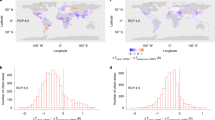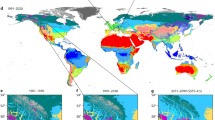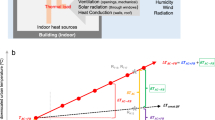Abstract
Efforts characterizing the changing climate of southwestern North America by focusing exclusively on the impacts of increasing levels of long-lived greenhouse gases omit fundamental elements with similar order-of-magnitude impacts as those owing to large-scale climate change1,2. Using a suite of ensemble-based, multiyear simulations, here we show the intensification of observationally based urban-induced phenomena and demonstrate that the direct summer-time climate effects of the most rapidly expanding megapolitan region in the USA—Arizona’s Sun Corridor—are considerable. Although urban-induced warming approaches 4 °C locally for the maximum expansion scenario, impacts depend on the particular trajectory of development. Cool-roof implementation reduces simulated warming by about 50%, yet decreases in summer-time evapotranspiration remain at least as large as those from urban expansion without this mode of adaptation. The contribution of urban-induced warming relative to mid- and end-of-century climate change illustrates strong dependence on built environment expansion scenarios and emissions pathways. Our results highlight the direct climate impacts that result from newly emerging megapolitan regions and their significance for overcoming present challenges concerning sustainable development3,4.
This is a preview of subscription content, access via your institution
Access options
Subscribe to this journal
Receive 12 print issues and online access
$209.00 per year
only $17.42 per issue
Buy this article
- Purchase on Springer Link
- Instant access to full article PDF
Prices may be subject to local taxes which are calculated during checkout




Similar content being viewed by others
References
Seager, R. et al. Model projections of an imminent transition to a more arid climate in southwestern North America. Science 316, 1181–1184 (2007).
Barnett, T. P. et al. Human-induced changes in the hydrology of the western United States. Science 319, 1080–1083 (2008).
Clark, W. C. Sustainability science: A room of its own. Proc. Natl Acad. Sci. USA 104, 1737–1738 (2007).
Stone, B. Jr Land use as climate change mitigation. Environ. Sci. Technol. 43, 9052–9056 (2009).
Zhou, L. et al. Evidence for a significant urbanization effect on climate in China. Proc. Natl Acad. Sci. USA 101, 9540–9544 (2004).
Grimm, N. B. et al. Global change and the ecology of cities. Science 319, 756–760 (2008).
Gober, P. & Kirkwood, C. W. Vulnerability assessment of climate-induced water shortage in Phoenix. Proc. Natl Acad. Sci. USA 107, 21295–21299 (2010).
Georgescu, M., Miguez-Macho, G., Steyaert, L. T. & Weaver, C. P. Climatic effects of 30 years of landscape change over the Greater Phoenix, Arizona, region:1. Surface energy budget changes. J. Geophys. Res. 114, D05110 (2009).
US Census Bureau, Population Division Interim State Population Projections (2005).
Grimm, N. B. et al. The changing landscape: ecosystem responses to urbanization and pollution across climatic and societal gradients. Front. Ecol. Environ. 6, 264–272 (2008).
Chow, W. T. L., Brennan, D. & Brazel, A. J. Urban heat island research in Phoenix, Arizona: Theoretical contributions and policy applications. Bull. Am. Meteorol. Soc. 93, 517–530 (2012).
Marshall, R. M., Robles, M. D., Majka, D. R. & Haney, J. A. Sustainable water management in the southwestern United States: reality or rhetoric? PLoS ONE 5, e11687 (2010).
Skamarock, W. C. & Klemp, J. B. A time-split nonhydrostatic atmospheric model for weather research and forecasting applications. J. Comput. Phys. 227, 3465–3485 (2008).
Chen, F. et al. The integrated WRF/urban modeling system: Development, evaluation, and applications to urban environmental problems. Int. J. Climatol. 31, 273–288 (2011).
Georgescu, M., Moustaoui, M., Mahalov, A. & Dudhia, J. An alternative explanation of the semiarid urban area oasis effect. J. Geophys. Res. 116, D24113 (2011).
Fry, J. et al. Completion of the 2006 national land cover database for the conterminous United States. Photogramm. Eng. Remote Sens. 77, 858–864 (2011).
Von Storch, H. & Zwiers, F. W. Statistical Analysis in Climate Research (Cambridge Univ. Press, 2002).
Dominguez, F., Villegas, J. C. & Breshears, D. D. Spatial extent of the North American Monsoon: Increased cross-regional linkages via atmospheric pathways. Geophys. Res. Lett. 36, L07401 (2009).
Menon, S., Akbari, H., Mahanama, S., Sednev, I. & Levinson, R. Radiative forcing and temperature response to changes in urban albedos and associated CO2 offsets. Environ. Res. Lett. 5, 014005 (2010).
Millstein, D. & Menon, S. Regional climate consequences of large-scale cool roof and photovoltaic array deployment. Environ. Res. Lett. 6, 034001 (2011).
Oleson, K. W., Bonan, G. W. & Feddema, J. Effects of white roofs on global temperature in a global climate model. Geophys. Res. Lett. 37, L03701 (2010).
Akbari, H. & Matthews, H. D. Global cooling updates: Reflective roofs and pavements. Energ. Buildings http://dx.doi.org/10.1016/j.enbuild.2012.02.055 (in the press, 2012).
Grimmond, et al. Initial results from Phase 2 of the international urban energy balance model comparison. Int. J. Climatol. 31, 244–272 (2011).
Seto, K. C., Fragkias, M., Guneralp, B. & Reilly, M. K. A meta-analysis of global urban land expansion. PLoS ONE 6, e23777 (2011).
McCarthy, M. P., Best, M. J. & Betts, R. A. Climate change in cities due to global warming and urban effects. Geophys. Res. Lett. 37, L09705 (2010).
Georgescu, M., Lobell, D. B. & Field, C. B. Direct climate effects of perennial bioenergy crops in the United States. Proc. Natl Acad. Sci. USA 108, 4307–4312 (2011).
Ek, M. B. et al. Implementation of Noah land surface model advances in the National Centers for Environmental Prediction operational mesoscale Eta model. J. Geophys. Res. 108, 8851 (2003).
Kain, J. S. The Kain–Fritsch convective parameterization: An update. J. Appl. Meteorol. 43, 170–181 (2004).
Kusaka, H. & Kimura, F. Thermal effects of urban canyon structure on the nocturnal heat island: Numerical experiment using a mesoscale model coupled with an urban canopy model. J. Appl. Meteorol. 43, 1899–1910 (2004).
Acknowledgements
We are grateful to N. Selover (Arizona state climatologist) for providing observational data and to A. Bagley (MAG) for providing Arizona 2050 growth-scenario data. This work was financially supported by National Science Foundation grant ATM-0934592.
Author information
Authors and Affiliations
Contributions
M.G. carried out the numerical simulations. M.G. and M.M. carried out the analysis. M.G., M.M., A.M. and J.D. designed the study and wrote the manuscript.
Corresponding author
Ethics declarations
Competing interests
The authors declare no competing financial interests.
Supplementary information
Supplementary Information
Supplementary Information (PDF 905 kb)
Rights and permissions
About this article
Cite this article
Georgescu, M., Moustaoui, M., Mahalov, A. et al. Summer-time climate impacts of projected megapolitan expansion in Arizona. Nature Clim Change 3, 37–41 (2013). https://doi.org/10.1038/nclimate1656
Received:
Accepted:
Published:
Issue Date:
DOI: https://doi.org/10.1038/nclimate1656
This article is cited by
-
The role of climate change and urban development on compound dry-hot extremes across US cities
Nature Communications (2023)
-
The interactions among landscape pattern, climate change, and ecosystem services: progress and prospects
Regional Environmental Change (2023)
-
Microclimatic effect of urban renewal: a case study of Kayseri/Turkey
Landscape and Ecological Engineering (2023)
-
Urban climate changes during the COVID-19 pandemic: integration of urban-building-energy model with social big data
npj Climate and Atmospheric Science (2022)
-
Evaporative misters for urban cooling and comfort: effectiveness and motivations for use
International Journal of Biometeorology (2022)



